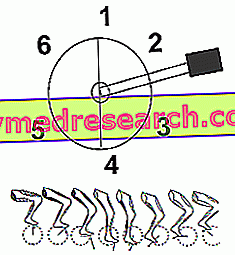Cycling is a sport in which muscular strength and endurance play a very important role. Together with the efficiency of the cardiovascular system these two abilities strongly condition athletic performance.
The winter preparation period cannot therefore disregard even the muscular components linked to the technical gesture of pedaling.
THE MUSCLES OF THE PEDALING
The technical analysis of pedaling is rather complex. The cyclic movement is in fact divided into different phases (at least 6) in each of which different muscles intervene.

In position 2 the heel tends to fall and the push action of quadriceps and triceps of the sura continuous. At the same time the extensor muscles of the thigh contract, captained by the large buttock which forcefully push the crank downwards (maximum propulsion phase).
In position 3, after the first 90 ° of movement, the flexor muscles of the leg also intervene (biceps femoris, sartorius, popliteus) and thigh (ileopsoas and rectus femoris) which flex the femur forward facilitating the recall of the leg towards the thigh.
In phase 4 the pushing action has practically been exhausted and the foot has almost reached its point of maximum flexion. The extensor muscles of the foot and the flexors of the big toe and of the plant cooperate to further lower the toe of the foot and to pull it backwards along with the flexors of the leg on the thigh.
In phase 5, after passing the lower dead point, the flexor muscles of the foot lower the heel until the foot is almost horizontal. In the meantime the muscles of the other leg enter the push phase facilitating the contralateral shooting movement.
In phase 6 the pedaling has almost completed its cycle returning to the upper dead point. Also in this phase the recovery of the pedal is allowed by the simultaneous action of the thigh flexors (ileopsoas and rectus femoris) and the flexor muscles of the foot (tibialis anterior and flexor of the big toe).
The study of the muscles involved in pedaling gives us an idea of the complexity of this only apparently trivial gesture. Further exploring the topic, we discover how the saddle position itself, the length of the cranks and the pedaling technique have a significant effect on the recruitment of the muscles during movement.
Thinking about how many times this gesture is repeated in a minute (70-120 times) we understand how fundamental it is to work so that the movement becomes as cheap and fluid as possible. The purpose of alternating contraction and relaxation of the various muscles is a capacity that can only be developed with training. This explains why, after a session of muscular development with overloads, a "transformation" and adaptation of the force through 10-20 minutes of exercise bike is suggested.
Objectives of winter preparation
Strengthening the large muscle groups involved in pedaling is just one of the many goals that a serious winter preparation program must set for itself. In this period of regeneration and muscular preparation it is necessary to set up a global type of work, aimed at the harmonious development of the muscles, the correction of possible muscular vices, the strengthening and improvement of the flexibility of each individual body district.
The main objectives of this phase include:
- strengthening of the muscles directly involved in pedaling
- correction of any muscle imbalance
- strengthening and strengthening of the auxiliary musculature (muscles that do not intervene directly in the athletic gesture but that play a very important role in stabilizing the body during pedaling)
- improvement of muscle flexibility
- improvement of pedaling technique and ankle mobility
- balance improvement by seeking destabilizing situations for the body's center of gravity
- introduction of any aerodynamic changes by correcting the position in the saddle
- cardiovascular conditioning (promoting muscle capillarization, increasing aerobic capacity)
Training methodology during winter preparation
PHASE I
The cyclist's winter training must be set according to the main objectives to be achieved in the following season. At first glance, some of these seem to be in stark contrast to each other: the increase in strength, for example, tends to shorten the muscle, making it stronger but less reactive and resistant. However, we must not forget the most important aspect of the winter preparation which is characterized by a global and harmonious approach that takes into account all the physical abilities, even those not directly linked to cycling.
MUSCULAR TONING: very important to improve the functionality of the athletic gesture must involve all the muscles of the body regardless of the physical characteristics of the cyclist (sprinter, passista, climber etc.). Only later will it be adapted according to individual objectives: the pure sprinter, for example, will perform specific work to improve maximum strength and power, while the climber will concentrate on developing the resistant force.
Precisely because it is a global training in the initial period it is good:
- always perform a general warm-up before starting the activity
start with a general training for example through functional exercises
- use light loads or practice free body gymnastics
- avoid heavy loads or dangerous movements
- be followed by experienced personnel
Muscle toning and balancing
Perform exercises that indiscriminately affect all large muscle groups (whether or not involved in cycling). After the first period, enter specific exercises that improve the strength of those groups that participate directly in bicycle workBASIC RESISTANCE: particularly useful in the period of recovery and regeneration are alternative activities such as running, swimming, cross-country skiing, skating, rowing, etc. It matters little if the musculature developed in some of these sports is not akin to that of cycling. During the regeneration and recovery period, the athlete must, as they say in jargon, "switch off" by engaging in his favorite sporting activity. As you go into the winter preparation period, these activities will gradually be abandoned, eventually continuing with the more similar ones such as cross-country skiing, cross-country skiing and skating.
The simple transition from a road bike to a cycle cross bike, a mtb bike, or a ciloturismo (and vice versa) requires an adaptation to the neuromuscular level that stimulates the improvement of motor coordination.
Precisely because of the "freedom" and psychophysical regeneration characterizing the period of regeneration or active rest, it would make no sense to impose particular frequencies, durations or intensity of training.
Some advices:
- choose a relaxing or alternative environment (beach, mountain, hill, etc.)
- maximum precaution to avoid injuries
- be assisted by a qualified instructor if you are not familiar with a particular sporting activity
- cover well and perform an adequate heating, since the regeneration phase coincides with the coldest months of the year
Alternative sports to cycling
Among the most sporting activities related to cycling we find cross-country skiing, skating and cyclocross. Mountain biking, in addition to exercising the conditional skills also improves technical skills, balance and courage. Less related activities like swimming, soccer, rowing, running, etc. they should be practiced only during the rest period and in the early stages of the winter preparatory cycle. In children and adolescents these activities are instead considered an integral part of physical preparation as they stimulate the complete development of basic motor skills.
FOOD: in this period the diet is characterized by leaving the cyclist some freedom in the choice of dishes. The diet will therefore be able to go beyond the rigorous standards imposed during the rest of the year. Among the typical autumn products, chestnuts are undoubtedly an excellent food for the cyclist thanks to their high content of starch, fiber, potassium and B vitamins.
FLEXIBILITY, COORDINATION AND BALANCE: these are very important qualities for a cyclist, especially at a young age. These characteristics are in fact necessary to: optimize the effectiveness of the athletic gesture, making it less wasteful from the energy point of view; to master the mechanical means with confidence and skill in the most insidious situations (descents, sudden obstacles, unfavorable environmental conditions); .
The development of coordination should be carried out at a young age (between 7 and 12 years)
Improve flexibility and coordination
These abilities can be improved indirectly during toning and endurance training. We have seen, for example, how the transition from racing bike to mountain bike and vice versa, stimulate coordination skills. Functional and free-body exercises to improve strength develop balance and body control.



